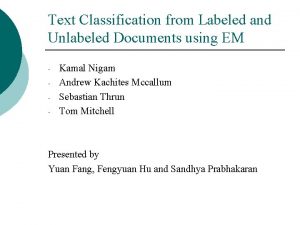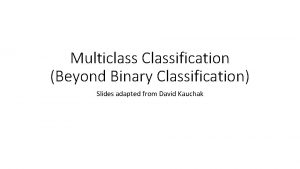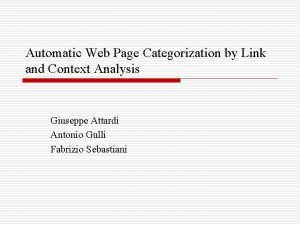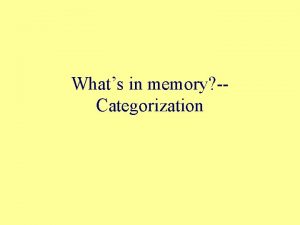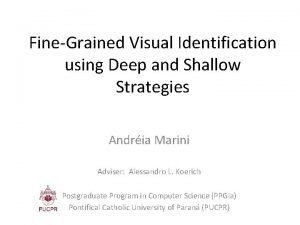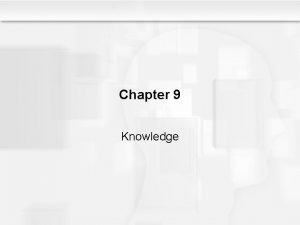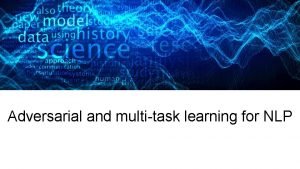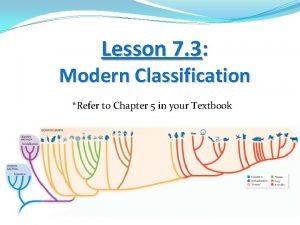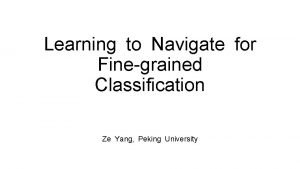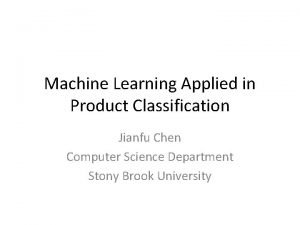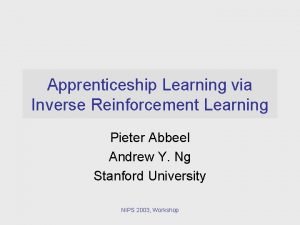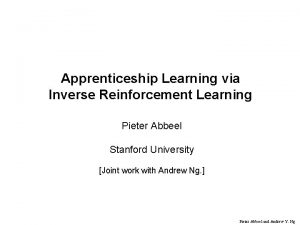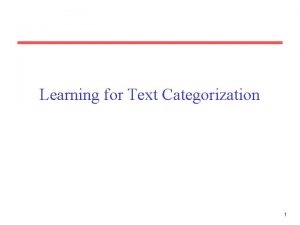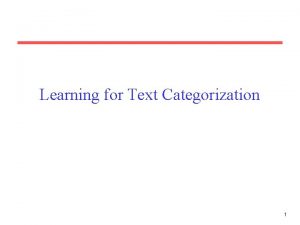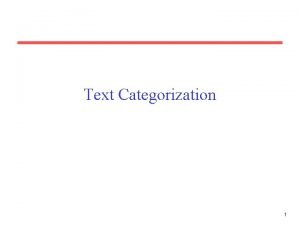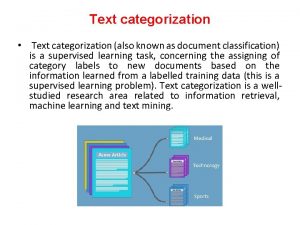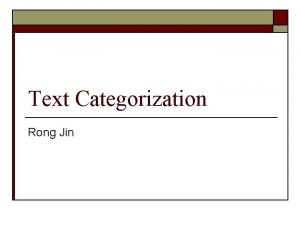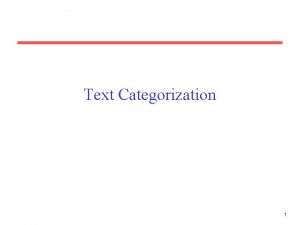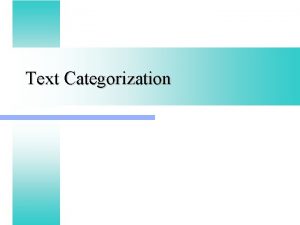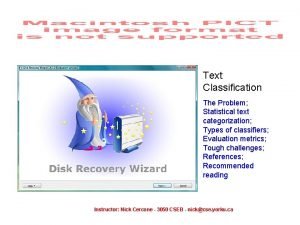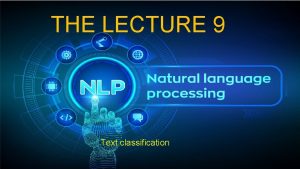Text Classification ActiveInteractive learning Text Categorization Categorization of


























- Slides: 26

Text Classification, Active/Interactive learning

Text Categorization • Categorization of documents, based on topics • When the topics are known – categorization (supervised) • When the topics are unknown – classification (a. k. a clustering, unsupervised)

Supervised learning • Training data – documents with their assigned (true) categories • Documents are represented by feature vectors x=(x 1, x 2, …, xn)

Document features • • • Word frequencies Stems/lemmas Phrases POS tags Semantic features (concepts, named entities) tdidf : tf = term frequency idf = inverse document frequency

TFIDF Weights TFIDF definitions: tfik: #occurrences of term tk in document Di dfk: #documents which contain tk idfk: log(d / dfk) where d is the total number of documents wik: tfik idfk term weight Intuition: rare words get more weight, common words less weight

Naïve Bayes classifier • Tightly tied to text categorization • Interesting theoretical properties • A simple example of an important class of learners based on generative models that approximate how data is produced • For certain special cases, NB is the best thing you can do

Bayes’ rule

Maximum a posteriori hypothesis As P(D) is constant

Maximum likelihood hypothesis If all hypotheses are a priori equally likely, we only need to consider the P(D|h) term:

Naive Bayes classifiers Task: Classify a new instance D based on a tuple of attribute values into one of the classes cj C

Naïve Bayes assumption • P(cj) – Can be estimated from the frequency of classes in the training examples. • P(x 1, x 2, …, xn|cj) – O(|X|n • |C|) parameters – Could only be estimated if a very, very large number of training examples was available. Naïve Bayes Conditional Independence Assumption: • Assume that the probability of observing the conjunction of attributes is equal to the product of the individual probabilities P(xi|cj).

Naive Bayes for text categorization • Attributes are text positions, values are words • Still too many possibilities • Assume that classification is independent of the positions of the words – Use same parameters for each position – Result is bag of words model (over tokens not types)

Naïve Bayes: learning probabilities • From training corpus, extract Vocabulary • Calculate required P(cj) and P(xk | cj) terms – For each cj in C do • docsj subset of documents for which the target class is cj • • Textj single document containing all docsj • for each word xk in Vocabulary – nk number of occurrences of xk in Textj –

Naïve Bayes: classifying • positions all word positions in current document which contain tokens found in Vocabulary • Return c. NB, where

Underflow Prevention

Binomial Naïve Bayes • One feature Xw for each word in dictionary • Xw = true in document d if w appears in d • Naive Bayes assumption: Given the document’s topic, appearance of one word in the document tells us nothing about chances that another word appears

Parameter Estimation • Binomial model: fraction of documents of topic cj in which word w appears • Multinomial model: fraction of times in which word w appears across all documents of topic cj – Can create a mega-document for topic j by concatenating all documents in this topic – Use frequency of w in mega-document

Learning probabilities • Passive learning – learning from the annotated corpus • Active learning – learning only from the most informative instances (real time annotation) • Interactive learning – the annotator can choose to suggest specific features (e. g. , playoffs to indicate sports) and not just complete instances

https: //github. com/burrsettles/dualist

{Inter}active learning • Available actions: – Annotate an instance with a class – Annotate a feature with a class – Suggest new feature and annotate it with a class

Adding prior to features’ max likelihood - Normalization factor (summing over all words)

Adding prior to classes’ max likelihood - Normalization factor (summing over all classes)

Semi-supervised (learning from unlabeled data) • Learning model probabilities ( ) using only priors • Apply the induced classifier on the unlabeled instances • Re-estimate the probabilities using the labeled as well as the probabilistically labeled instances (multiply the latters with 0. 1 to avoid over whelming the model) • Possibly iterating this processes • This is actually EM

Suggesting instances for annotation • Use weight function • For example, entropy-based uncertainty weight: Document d • Then, suggest the top D documents

Suggesting features for annotation • Using info-gain • Then, suggest the top V features for the class with which they occur most

Results of 3 annotators, comparing active, interactive and passive learning (Closing the Loop: Fast, Interactive Semi-Supervised Annotation With Queries on Features and Instances, Burr Settles)
 What is text categorization
What is text categorization Making connections images
Making connections images Pineapple categorization binary
Pineapple categorization binary Web page categorization
Web page categorization Prototype in psychology
Prototype in psychology Fine-grained visual categorization
Fine-grained visual categorization The definitional approach to categorization
The definitional approach to categorization Cuadro comparativo e-learning y b-learning
Cuadro comparativo e-learning y b-learning Multi task learning nlp
Multi task learning nlp Eager classification versus lazy classification
Eager classification versus lazy classification A graph is a
A graph is a Traditional classification vs modern classification
Traditional classification vs modern classification Learning to navigate for fine-grained classification
Learning to navigate for fine-grained classification Product classification machine learning
Product classification machine learning Classification
Classification Lda supervised or unsupervised
Lda supervised or unsupervised Concept learning task in machine learning
Concept learning task in machine learning Analytical learning in machine learning
Analytical learning in machine learning Associative learning example
Associative learning example What is conceptual learning
What is conceptual learning Analytical learning in machine learning
Analytical learning in machine learning Apprenticeship learning via inverse reinforcement learning
Apprenticeship learning via inverse reinforcement learning Apprenticeship learning via inverse reinforcement learning
Apprenticeship learning via inverse reinforcement learning Deductive reasoning
Deductive reasoning Pac learning model in machine learning
Pac learning model in machine learning Perbedaan supervised dan unsupervised
Perbedaan supervised dan unsupervised Pac learning model in machine learning
Pac learning model in machine learning
